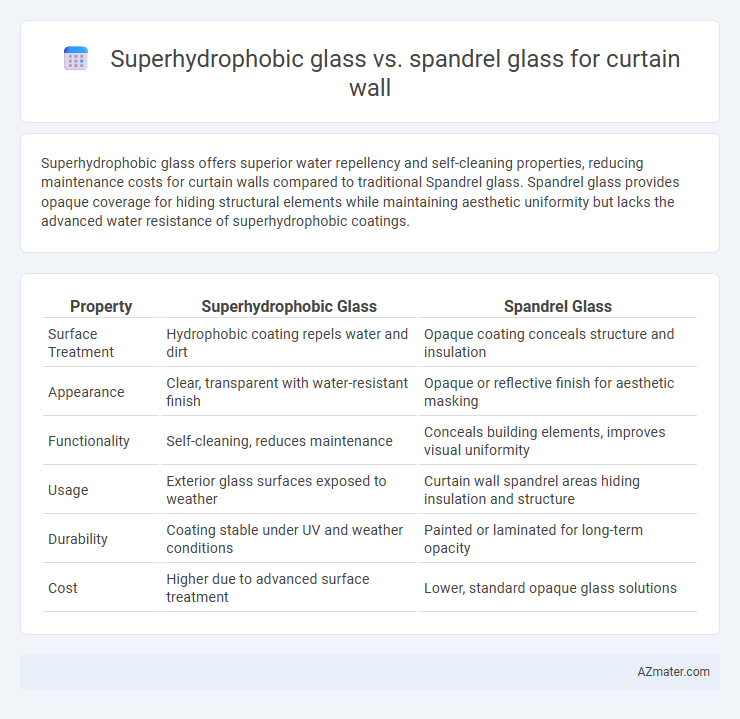Superhydrophobic glass offers superior water repellency and self-cleaning properties, reducing maintenance costs for curtain walls compared to traditional Spandrel glass. Spandrel glass provides opaque coverage for hiding structural elements while maintaining aesthetic uniformity but lacks the advanced water resistance of superhydrophobic coatings.
Table of Comparison
| Property | Superhydrophobic Glass | Spandrel Glass |
|---|---|---|
| Surface Treatment | Hydrophobic coating repels water and dirt | Opaque coating conceals structure and insulation |
| Appearance | Clear, transparent with water-resistant finish | Opaque or reflective finish for aesthetic masking |
| Functionality | Self-cleaning, reduces maintenance | Conceals building elements, improves visual uniformity |
| Usage | Exterior glass surfaces exposed to weather | Curtain wall spandrel areas hiding insulation and structure |
| Durability | Coating stable under UV and weather conditions | Painted or laminated for long-term opacity |
| Cost | Higher due to advanced surface treatment | Lower, standard opaque glass solutions |
Introduction to Curtain Wall Glass Technologies
Curtain wall glass technologies feature innovations like superhydrophobic glass, designed with nanoscale surface textures to repel water and reduce dirt accumulation, enhancing building facade longevity and maintenance efficiency. Spandrel glass, often opaque or coated, conceals structural elements and insulation within curtain wall systems, contributing to aesthetic uniformity and thermal performance. Selecting between superhydrophobic and spandrel glass depends on balancing functional requirements such as weather resistance, visual appearance, and energy efficiency in modern architectural designs.
What is Superhydrophobic Glass?
Superhydrophobic glass features a surface treatment that repels water by creating micro- and nanoscale textures, resulting in a water contact angle greater than 150deg, which prevents water accumulation and promotes self-cleaning. This glass enhances curtain wall performance by reducing maintenance needs and improving transparency under wet conditions compared to spandrel glass, which primarily serves aesthetic and thermal insulation roles without hydrophobic properties. The advanced water-repellent characteristics of superhydrophobic glass make it ideal for exterior applications exposed to frequent rain or environmental contaminants.
What is Spandrel Glass?
Spandrel glass is an opaque or translucent glass panel used in curtain walls to conceal structural elements, insulation, and mechanical systems, enhancing the building's aesthetic appearance. Unlike superhydrophobic glass, which is coated to repel water and reduce maintenance by preventing water spots and dirt accumulation, spandrel glass primarily serves architectural and functional purposes by providing uniformity and hiding non-visual components. It often matches the vision glass in color and texture, ensuring a seamless facade while improving thermal performance and privacy.
Key Properties: Superhydrophobic vs Spandrel Glass
Superhydrophobic glass features an ultra-water-repellent surface that significantly reduces water and dirt adhesion, enhancing self-cleaning properties for curtain walls. Spandrel glass provides opaque or translucent cladding designed to conceal structural components or insulation, offering thermal insulation and aesthetic uniformity. While superhydrophobic glass optimizes maintenance and visibility, spandrel glass prioritizes concealment and energy efficiency in building facades.
Performance Comparison: Durability and Maintenance
Superhydrophobic glass exhibits superior durability by effectively repelling water, dirt, and dust, resulting in less frequent cleaning and lower maintenance costs compared to spandrel glass. Spandrel glass, often coated or painted for opacity, may suffer from coating degradation and increased susceptibility to staining over time, leading to higher maintenance demands. The enhanced self-cleaning properties of superhydrophobic glass significantly reduce environmental wear, making it a more sustainable choice for curtain wall performance.
Thermal Insulation and Energy Efficiency
Superhydrophobic glass offers enhanced thermal insulation through its water-repellent coating, reducing heat transfer and minimizing condensation, which improves energy efficiency in curtain wall systems. Spandrel glass, typically opaque and insulated, contributes to thermal performance by concealing structural elements and providing an additional insulating layer that reduces thermal bridging. When optimizing curtain walls for energy efficiency, combining superhydrophobic coatings on vision glass with spandrel glass panels can significantly lower heating and cooling loads by enhancing overall thermal resistance and reducing moisture-related thermal losses.
Aesthetic Options and Visual Impact
Superhydrophobic glass offers a sleek, self-cleaning surface that maintains a pristine appearance, enhancing natural light transmission and preserving clear views in curtain wall designs. Spandrel glass provides versatile aesthetic options with opaque finishes, concealing structural elements or mechanical equipment while contributing to the facade's uniformity and color consistency. The visual impact of superhydrophobic glass emphasizes transparency and brightness, whereas spandrel glass focuses on creating seamless design integration and architectural expression.
Cost Analysis and Budget Considerations
Superhydrophobic glass generally incurs higher upfront costs due to advanced surface coatings and durability enhancements compared to standard spandrel glass, which is often more economical because of its opacity and simpler manufacturing process. Budget considerations must account for long-term maintenance savings with superhydrophobic glass, as its water-repellent properties reduce cleaning frequency and associated labor expenses, whereas spandrel glass may require periodic replacement or more intensive upkeep. Project budgets should balance initial investment against lifecycle costs, factoring in the performance benefits of superhydrophobic glass for exterior curtain wall applications versus the cost-effectiveness and aesthetic customization options of spandrel glass.
Suitability for Different Project Types
Superhydrophobic glass offers superior water repellency and self-cleaning properties, making it ideal for high-rise buildings in humid or rainy climates where maintenance access is challenging. Spandrel glass, often used to conceal structural elements and insulation, suits commercial projects where aesthetic uniformity and energy efficiency are priorities. Choosing between these materials depends on project requirements such as environmental exposure, visual design goals, and maintenance considerations.
Final Recommendations: Choosing the Right Glass for Curtain Walls
Superhydrophobic glass offers superior water repellency and self-cleaning properties, making it ideal for buildings in humid or rainy environments, while spandrel glass provides effective concealment for structural components and insulation in curtain wall systems. Selection depends on project priorities: opt for superhydrophobic glass when maintenance reduction and surface cleanliness are critical, and choose spandrel glass to achieve uniform exterior appearance and thermal efficiency. For optimal curtain wall performance, combine both types strategically to balance aesthetics, durability, and energy performance based on site-specific conditions.

Infographic: Superhydrophobic glass vs Spandrel glass for Curtain wall
 azmater.com
azmater.com